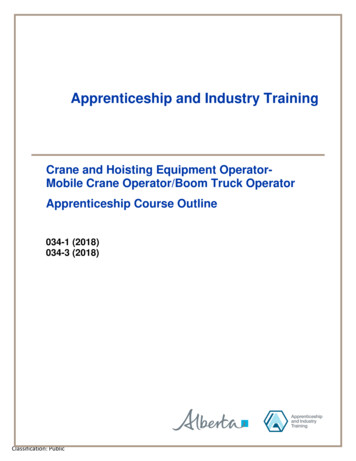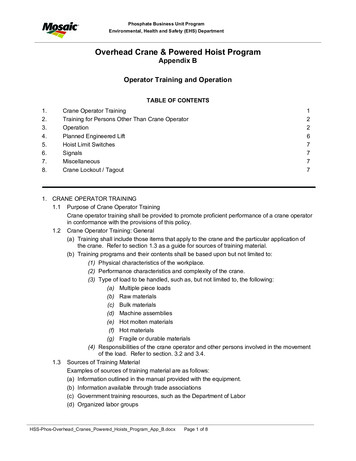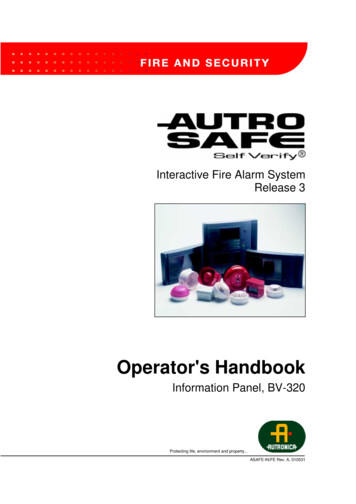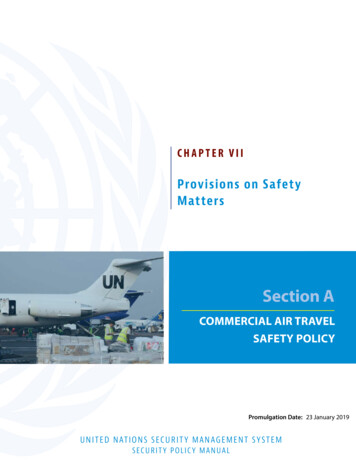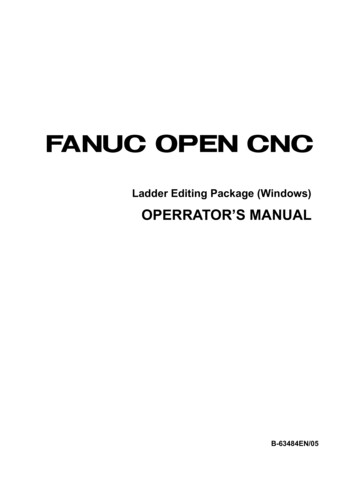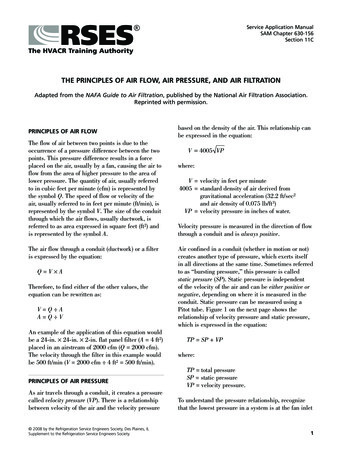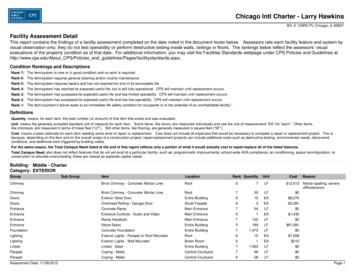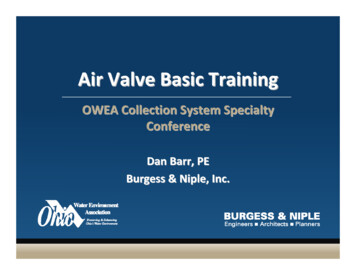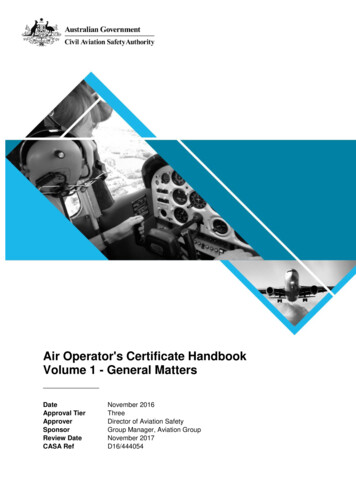
Transcription
Air Operator's Certificate HandbookVolume 1 - General MattersDateApproval TierApproverSponsorReview DateCASA RefNovember 2016ThreeDirector of Aviation SafetyGroup Manager, Aviation GroupNovember 2017D16/444054
AOC Handbook Volume 1 - General Matters Civil Aviation Safety AuthorityThis work is copyright. You may download, display, print and reproduce this material inunaltered form only (retaining this notice) for your personal, non-commercial use or usewithin your organisation. Apart from any use permitted under the Copyright Act 1968, allother rights are reserved.This document becomes an uncontrolled document when printed. Refer to www.casa.gov.au/scripts/nc.dll?WCMS:STANDARD::pc PC 91264 for current version.This is an internal CASA policy manual. It contains guidance material intended to assist CASAofficers and delegates in carrying out their regulatory responsibilities and is available to thepublic for information purposes only.You should not rely on this manual as a legal reference. Refer to the civil aviation legislation—including the Civil Aviation Act 1988 (Cth), its related regulations and any other legislativeinstruments—to ascertain the requirements of, and the obligations imposed by or under, thelaw.Uncontrolled when printed
AOC Handbook Volume 1 - General MattersPrefaceAs a Commonwealth government authority, CASA must ensure that the decisions we make,and the processes by which we make them, are effective, efficient, fair, timely, transparent,properly documented and otherwise comply with the requirements of the law. At the sametime, we are committed to ensuring that all of our actions are consistent with the principlesreflected in our Regulatory Philosophy.Most of the regulatory decisions CASA makes are such that conformity with authoritativepolicy and established procedures will lead to the achievement of these outcomes.Frequently, however, CASA decision-makers will encounter situations in which the strictapplication of policy may not be appropriate. In such cases, striking a proper balancebetween the need for consistency and a corresponding need for flexibility, the responsibleexercise of discretion is required.In conjunction with a clear understanding of the considerations mentioned above, and athorough knowledge of the relevant provisions of the civil aviation legislation, adherence to theprocedures described in this manual will help to guide and inform the decisions you make,with a view to better ensuring the achievement of optimal outcomes in the interest of safetyand fairness alike.Shane CarmodyChief Executive Officer andDirector of Aviation SafetyVersion 1.1 - November 2016Uncontrolled when printedCivil Aviation Safety AuthorityD16/444054Page 3 of 49
AOC Handbook Volume 1 - General MattersTable of contentsPrefaceGlossaryRevision history35101.Introduction1.1 About the AOC Handbook1.2 The Structure of the Handbook1111122.Air Operator's Certificate Overview2.1 What is an Air Operator’s Certificate?2.2 Who May Apply for an Air Operator’s Certificate?2.3 Types of Authorisation2.4 The AOC Processes15151515163.Applicable Legislation184.Certification Process4.1 CASA Responsibilities4.2 Applicant’s Responsibilities4.3 Process Overview4.4 Enquiry4.5 Application Phase4.6 Assessment Phase4.7 Certification Phase19191920222330335.AOC Project Management5.1 Project Management5.2 Financial assessments5.3 Qualifications of the CASA Project Team Members5.4 Guidelines for the Project Teams5.5 Project Planning5.6 Project Monitoring373737383940406.Financial Viability Assessment6.1 Financial assessments6.2 Entry control requirements6.3 Types of assessments6.4 Information required for CASA assessments6.5 Assessment Process6.6 Confidentiality of Information Provided424242434445457.Carriers’ Liability Scheme Applicable Legislation7.1 Requirements7.2 Who to contact494949Version 1.1 - November 2016Uncontrolled when printedCivil Aviation Safety AuthorityD16/444054Page 4 of 49
AOC Handbook Volume 1 - General MattersGlossaryAcronyms and abbreviationsAcronym / abbreviationDescriptionAACAirworthiness Advisory CircularACAdvisory CircularACASAirborne Collision Avoidance SystemACNAustralian Company NumberActCivil Aviation Act 1988 as amendedADAirworthiness Directive (issued under CASR)AFMAircraft Flight ManualAOCAir Operator’s CertificateAPUAuxiliary Power UnitARNAviation Reference Number (a CASA derived number)AROCPAircraft Radar Operational Certificate of ProficiencyASETPAApproved Single Engine Turbine Powered AeroplanesASOMAviation Safety Occurrence ManualATOApproved Training Organisation(s)ATPLAir Transport Pilot LicenceATSBAustralian Transport Safety BureauAWBAirworthiness BulletinCAACivil Aviation Authority (precursor to CASA)CAAPCivil Aviation Advisory PublicationCAOCivil Aviation OrderCAPCivil Aviation Publication (United Kingdom)CARCivil Aviation Regulations 1988CASACivil Aviation Safety AuthorityCASRCivil Aviation Safety Regulations 1998CDLConfiguration Deviation ListCEOChief Executive OfficerCFIChief Flying InstructorCGCentre of GravityCOACertificate of ApprovalC of RCertificate of RegistrationCSCClient Services CentreVersion 1.1 - November 2016Uncontrolled when printedCivil Aviation Safety AuthorityD16/444054Page 5 of 49
AOC Handbook Volume 1 - General MattersAcronym / abbreviationDescriptionCVCertificate of ValidationDAMPDrug and Alcohol Management PlanDGDangerous GoodsDGRDangerous Goods RegulationDHDecision HeightEASAEuropean Aviation Safety AuthorityEDTOExtended Diversion Time OperationsEROPSExtended Range OperationsERSAEn Route Supplement AustraliaETOPSExtended Range Twin Engine OperationsFAAFederal Aviation Administration of the United States of AmericaFARFederal Aviation Regulation Issued by FAAFCOMFlight Crew Operating ManualsFCSFlight Control SystemFEFlight EngineerGNSS (RNAV)Global Navigation Satellite SystemGPWSGround Proximity Warning SystemGSEGround Services EquipmentHCRPTHigh Capacity Regular Public TransportHUDHead up DisplayIATAInternational Air Transport AssociationICAOInternational Civil Aviation OrganisationIFRInstrument Flight RulesILS PRMInstrument Landing System Precision Runway MonitorsJAAJoint Aviation Authorities in EuropeJARJoint Aviation Regulation issued by JAALAHSOLand and Hold Short OperationsLARPISLBALuftfahrt Bundesamt -German Airworthiness AuthorityLCRPTLow-Capacity Regular Public TransportMCMMaintenance Control ManualMDA/HMinimum Descent Altitude/HeightMDRMajor Defect ReportMEFMaterials Evaluation FacilityVersion 1.1 - November 2016Uncontrolled when printedCivil Aviation Safety AuthorityD16/444054Page 6 of 49
AOC Handbook Volume 1 - General MattersAcronym / abbreviationDescriptionMELMinimum Equipment ListMMELMaster Minimum Equipment ListMoUMemorandum of UnderstandingMRBMaintenance Review BoardMTOWMaximum Take Off WeightNAANational Airworthiness AuthorityNOFNOTAM OfficeNOTOCNotification to CaptainNTONo Technical ObjectionOLSObstacle Limitation SurfacesPICPilot in CommandPBSProtective Breathing EquipmentPUSPermissible Unserviceability ListPRMPrecision Runway MonitorQRHQuick Reference HandbookRDHReference Datum HeightRLDRijksluchtvaartdienst-Netherlands Airworthiness AuthorityRNPRequired Navigation PerformanceRPTRegular Public TransportRVSMReduced Vertical Separation MinimaSARSearch and RescueSFRStandard Form Recommendation-internal CASA processSODPROPSSimultaneous Opposite Direction Parallel Runway OperationsSOMSystem of MaintenanceSPLSpecial Purpose LaneSSAASafety Sensitive Aviation ActivitiesSTCSupplemental Type CertificateTCType CertificateTCASTraffic Collision Avoidance SystemTOWTake-off WeightVFRVisual Flight RulesWCAWeight Control AuthorityVersion 1.1 - November 2016Uncontrolled when printedCivil Aviation Safety AuthorityD16/444054Page 7 of 49
AOC Handbook Volume 1 - General MattersDefinitionsTermDefinitionApplicantA legal entity applying for an Air Operator’s Certificate – also referredto as the proposed certificate holder in this handbook.OperatorA legal entity who holds an Air Operator's CertificateAir Operator's Certificate(AOC)An Air Operator's Certificate (AOC) is a permission granted by CASAunder section 27 of the Civil Aviation Act to conduct commercialactivities prescribed in CAR 206.CASA Project ManagerThe CASA Project Manager is responsible for managing the overallassessment process and, in particular, the coordination of the projectteam members in the assessment phase. The CASA Project Manageris also responsible for monitoring and reviewing the progress of theassessment including the assessment cost.CASA Project TeamA group of CASA staff responsible for assessing an application for anAOC. The size of the CASA Project Team is determined by the scopeand complexity of the AOC application. In some cases, the team couldbe comprised of only one CASA inspector.CASA Region ManagerA CASA Officer who has overall responsibility for effectivemanagement of a CASA Region Office, ensuring standardisation ofoperations and consistent application processes.CASA Region OfficeThe CASA Office responsible for assessing the AOC applicationsaccording to the procedures outlined in this AOC Process Manual andthe AOC Handbook, and advising the CASA delegate of therecommended action in relation to an application.Certificate Team ManagerA CASA Officer who is responsible for task allocations, resourcemanagement and consistent application of processes within theirteam. The Team Manager liaises with the CASA Project Managersand the CASA Region Manager to ensure adequate resources areavailable for assessments.AOC HolderA legal entity who holds an Air Operator’s Certificate.Controlling OfficeThe CASA Region Office responsible for the operational oversight ofthe issued AOC.Conducting OfficeThe CASA Region Office responsible for the assessment of the AOCapplication.DelegateA CASA officer who has the authority, for the purposes of thishandbook, to make a decision to issue, refuse, suspend or cancel anAir Operator’s Certificate under the Civil Aviation Act.Entry ControlCommon term used to describe the process to assess an applicant,for the purposes of issuing a permission to undertake a particularaviation activity.High Capacity AircraftAn aircraft with maximum seating capacity exceeding 38 seats ormaximum payload exceeding 4,200 kilograms – See CAO 82.0.Large Capacity AircraftAn aircraft MTOW 15000kg seating 30 (CAR 2)CASA InspectorA CASA officer who conducts the assessment to ensure that anVersion 1.1 - November 2016Uncontrolled when printedCivil Aviation Safety AuthorityD16/444054Page 8 of 49
AOC Handbook Volume 1 - General MattersTermDefinitionapplicant has satisfactorily met the requirements set by legislation forthe issue of an Air Operator’s Certificate.The officer must have completed the discipline specific requisitemandatory training as prescribed by CASA for the associatedapproval.Legal EntityA natural person or a body having legal personality, capable ofenjoying and being subject to legal rights and duties established underrelevant state or Commonwealth law.Low Capacity AircraftAny aircraft other than high capacity aircraftPermissionGeneral term used to describe all civil aviation authorisations issuedby CASA that authorise a person or organisation to undertake aparticular aviation-related activity. Includes all licences, permits,approvals, authorisations, certificates, exemptions and delegations.Client Services Centre (CSC)CASA’s single point of contact for AOC applications under thedirection of Industry Permissions. CSC processes applications,provides information to applicants and receives payments. It registerstracks and monitors compliance with service delivery standards.Version 1.1 - November 2016Uncontrolled when printedCivil Aviation Safety AuthorityD16/444054Page 9 of 49
AOC Handbook Volume 1 - General MattersRevision historyAmendments/revisions of this manual are recorded below in order of most recent first.Version No.DateParts/SectionsDetails1.1Nov 2016AllComplete update1.0Oct 2012AllFirst issueVersion 1.1 - November 2016Uncontrolled when printedCivil Aviation Safety AuthorityD16/444054Page 10 of 49
AOC Handbook Volume 1 - General Matters1.Introduction1.1About the AOC HandbookAnyone intending to conduct any commercial activities prescribed in the aviation regulations(such as aerial, charter and regular public transport operations in reg. 206 of the Civil AviationRegulations 1988, or foreign air transport operations in Part 129 of the Civil Aviation SafetyRegulations 1998 (CASR), or certain flying training under CASR Part 142), is required to havean Air Operator’s Certificate (AOC).The AOC Handbook is part of the AOC Manual Suite which provides applicants withinformation on how to obtain an Air Operator’s Certificate for the above operations. It alsoprovides existing certificate holders with information on how to maintain their certificate or varytheir existing AOC.The AOC Handbook supports the AOC Process Manual, which outlines the steps CivilAviation Safety Authority (CASA) and the applicant need to take to process an application foran AOC.This Handbook is subject to a continuous improvement program and as such is undercontinuous development and review. Submissions for change or amendment can besubmitted as per the Continuous Improvement Process tocontinuousimprovement@casa.gov.au.1.1.1 Purpose of the HandbookThe purpose of this handbook is to provide CASA staff with policy and guidance onstandardising entry control requirements for the processing of an application for an AirOperator’s Certificate.It provides CASA and industry with an explanation of the AOC issue and change process, andprovides guidance on the requirements for obtaining, changing and maintaining an AOC.The Handbook, together with the other documents in the AOC Manual Suite, aims to establishtransparency in CASA decision-making process.1.1.2 Who this Handbook is forThis Handbook is for the use of both CASA staff, and persons or organisations applying for orholding an Air Operator’s Certificate.This handbook does not apply to applicants wishing to operate Remotely Piloted AerialSystems (RPAS) and Sport or Recreational Aviation.1.1.3 What this Handbook CoversThis Handbook sets out the guidance information for the issue of or a change to an AirOperator’s Certificate and covers a wide range of activities encompassing aerial work, charterand RPT operations.The Handbook: outlines the legislative requirements and policies which support the AOC process provides detailed guidance material to support completion of a process step.Version 1.1 - November 2016Uncontrolled when printedCivil Aviation Safety AuthorityD16/444054Page 11 of 49
AOC Handbook Volume 1 - General MattersThe Handbook also sets out the criteria that CASA requires an applicant to meet to obtain anAOC. The applicant must ensure that they have the systems, procedures, premises,equipment and the personnel necessary to ensure that aviation safety is not compromised.1.1.4 What this Handbook Does Not CoverThis Handbook does not cover the maintenance requirements of Part 42 of the CASR forRegular Public Transport (RPT) operations. For guidance on the requirements of Part 42,please refer to its Manual of Standards and Part 42G – Continuing Airworthiness ManagementOrganisation (CAMO) Assessor Handbook.Information can also be found on the CASA website.1.1.5 Using the AOC HandbookCASA staff are required to follow the procedures and policies in this handbook. An applicantmay use these policies and procedures as guidance when preparing for an AOC application.By adhering to handbook’s policies and procedures, a standard and unified approachconsistent with regulatory requirements will be maintained when issuing an Air Operator’sCertificate.The Civil Aviation legislation provides few distinctions between small scale and large scaleoperations because the basic principles of sound operating practice are essentially similar atall levels. However, CASA will apply the guidance information in this handbook as appropriate,giving due consideration to the size, complexity and particular circumstances of the applicant.Where deviation from the policies and procedures contained in this handbook is required,such deviation must be approved by the CASA Senior Manager, Safety Assurance.In this handbook the words must or shall are used to indicate that CASA requires the policy orprocedure to be adhered to. The word recommended is used to indicate that a greater degreeof latitude may be exercised and the CASA team member will use their experience andtraining to make a decision based on the information available.1.2The Structure of the Handbook1.2.1 The AOC Manual SuiteThis AOC Handbook is part of the AOC Manual Suite that provides guidance on applying for,issuing and maintaining an AOC. The Suite consists of the following, as shown in the diagrambelow (Figure 1): The AOC Process Manual This Handbook The AOC Forms.Version 1.1 - November 2016Uncontrolled when printedCivil Aviation Safety AuthorityD16/444054Page 12 of 49
AOC Handbook Volume 1 - General MattersFigure 1: AOC Manual SuiteThe AOC Process Manual sets out the process that the applicant and CASA must follow fromenquiry, to assessment and issue of an AOC. It is designed as a fast, quick-referencemechanism that standardises how CASA Inspectors carry out the assessment activities. Italso outlines the points of interaction between CASA and the aviation industry in the conductof these activities. The full version of the Air Operator’s Certificate Process Manual is availableon the CASA website.The Handbook deals with the detailed information on the assessment criteria and policies forthe issue of an AOC. The Handbook aligns with and supports the AOC Process Manual byproviding detailed explanations on the requirements outlined in the process steps. The AOCHandbook is divided into five volumes: Volume 1 – AOC General Matters Volume 2 – Flying Operations Volume 3 – Airworthiness Volume 4 – Specialist Areas(Dangerous Goods, Cabin Safety, Ground Operations, Drug and Alcohol Management Plans,Aerodromes and Safety Management Systems) Volume 5 – International Operations(Foreign Air Transport Operators).Electronic Forms and ManualsCASA has developed electronic tools to assist industry in the certificate application processand to build manuals.CASA will accept for assessment applications and manuals developed using the electronictools. It is expected that CASA staff will also return manuals to the applicant for rework byelectronic means.Another feature of electronic tools is the ability of industry to produce and submit electronicapplication forms and manuals. The tools also provide for online assessment and return to theapplicant for rework. In some cases, industry is required to supply CASA with a copy of theVersion 1.1 - November 2016Uncontrolled when printedCivil Aviation Safety AuthorityD16/444054Page 13 of 49
AOC Handbook Volume 1 - General Mattersapproved or accepted manuals. These manuals can be provided to CASA in an electronicform.The AOC Application Forms allow an applicant to submit an application for an AOC andCASA to assess the application. The suite of AOC Application Forms is the CASA approvedforms for applying for an Air Operator’s Certificate.1.2.2 Where to Get Further Information/AssistanceTo obtain further assistance with any of the information contained within this handbook,contact the Client Services Centre (CSC) Brisbane on 136 773 or visit the CASA website atwww.casa.gov.au.To make suggestions regarding amendments to this handbook, emailcontinuousimprovement@casa.gov.au.CASA may, by notice in writing served on the AOC holder, cancel, suspend or vary thecertificate where CASA is no longer satisfied that the AOC holder meets the safety andlegislative requirements.The process involving administrative action is coordinated by CASA Legal (LARPIS). If acertificate is cancelled, suspended or varied as a result of enforcement action, a job still needsto be raised by CSC to include details of the action in the database.Version 1.1 - November 2016Uncontrolled when printedCivil Aviation Safety AuthorityD16/444054Page 14 of 49
AOC Handbook Volume 1 - General Matters2.Air Operator's Certificate Overview2.1What is an Air Operator’s Certificate?An Air Operator’s Certificate (AOC) is a permission granted by CASA under section 27 of theAct to conduct commercial operations prescribed in CAR 206 by: aircraft flying into, or out of, Australian Territory aircraft flying in Australian Territory Australian aircraft flying outside Australian Territory.All AOCs are issued for a specified period. To continue operating, an AOC holder must applyfor, and be issued with, a new AOC prior to the expiry of the existing AOC.If you are not sure about whether you require an AOC, please contact the CASA ClientService Centre (CSC) on 136 773 or by email at regservices@casa.gov.au.Who May Apply for an Air Operator’s Certificate?2.2Any legal entity may apply for an AOC. This includes: a natural person or a group of natural persons an incorporated company or association, or a group thereof a body corporate or politic created by statute.CASA requirements on legal identity checks are set out in detail in the AOC HandbookVolume 1 - 4.5.5 Legal Entity.2.3Types of AuthorisationThe following commercial purposes can be approved under an AOC: Aerial Work Charter Regular Public Transport.2.3.1 Aerial WorkAerial work activities include the following: Aerial Advertising Aerial Agricultural Operations Aerial Photography Aerial Spotting Aerial Stock Mustering Aerial Surveying Ambulance Functions Dropping Feral and diseased animal controlVersion 1.1 - November 2016Uncontrolled when printedCivil Aviation Safety AuthorityD16/444054Page 15 of 49
AOC Handbook Volume 1 - General Matters Frost Protection Power line Rappelling Search and Rescue Sling Load Operations Surveillance Target Towing Trade Operations Winching and Hoist Carriage, for trading purposes, of goods owned by the pilot, owner or hirer of theaircraft on schedules that are not fixed and terminals Flying training, other than conversion training or training carried out under anexperimental certificate issued under regulation 21.195A of Civil Aviation SafetyRegulations (CASR) or under a permission to fly in force under sub regulation 317of the Civil Aviation Regulations (CAR 1988).2.3.2 CharterCharter operations covers: the carriage of passengers or cargo for hire or reward to or from any place, otherthan carriage in accordance with fixed schedules to and from fixed terminals orcarriage for an operation mentioned in sub regulation 262AM(7) of CAR 1988 orunder a permission to fly in force under sub regulation 317(1) CAR 1988 carriage, in accordance with fixed schedules to and from fixed terminals, ofpassengers and/or cargo in circumstances in which the accommodation in theaircraft is not available to persons generally.2.3.3 Regular Public TransportRegular Public Transport operations covers the transport of persons or cargo for hire orreward in accordance with fixed schedules to and from fixed terminals over specific routeswith or without intermediate stopping places between terminals.2.4The AOC Processes2.4.1 AOC Certification ProcessThe AOC certification process consists of four main phases: Enquiry Application Assessment Certification.Detailed information regarding these phases is discussed in Vol 1, Chapter 4 of thishandbook.Version 1.1 - November 2016Uncontrolled when printedCivil Aviation Safety AuthorityD16/444054Page 16 of 49
AOC Handbook Volume 1 - General Matters2.4.2 Cancellation at AOC holder’s requestCASA must cancel an AOC if the AOC holder makes a written request. There is no specifiedform for the cancellation of an AOC.Before actioning a cancellation request, CASA must ensure that the person requesting thecancellation has the authority to do so.The process for cancellation at the request of the AOC holder is detailed in Section 2.0 of theAOC Process Manual.2.4.3 Cancellation, suspension or variation as a result of Enforcement ActionIt is the responsibility of the AOC Holder to ensure the commercial operations authorised bythe AOC continues to comply with legislative requirements.CASA may, by notice in writing served on the AOC holder, cancel, suspend or vary thecertificate where CASA is no longer satisfied that the AOC holder meets the safety andlegislative requirements.The process involving administrative action is coordinated by CASA Legal Services Division. Ifa certificate is cancelled, suspended or varied as a result of enforcement action, a job stillneeds to be raised by CSC to include details of the action in the database.Version 1.1 - November 2016Uncontrolled when printedCivil Aviation Safety AuthorityD16/444054Page 17 of 49
AOC Handbook Volume 1 - General Matters3.Applicable LegislationThe following is a list of legislation and advisory material that is relevant to AOCs: Civil Aviation Act 1988 ( the Act) Civil Aviation Regulations 1988 (CAR) and Civil Aviation Safety Regulations 1998(CASR) Civil Aviation Orders (CAO) Manual of Standards (MOS) Advisory Information including: Civil Aviation Advisory Publications (CAAP) Advisory Circulars (AC) CASA Policy Acceptable Means of Compliance (AMC) Guidance Material (GM).All CASA officers involved in the issue of an AOC must, in the first instance, familiarisethemselves with Division 2 of Part III of the Act which sets out the legal framework for theissue on an AOC. If clarification is required on the above, it is recommended officers seeklegal advice.Section 28 of the Act deals with matters about which CASA must be satisfied before an AOCis issued. If CASA is not satisfied that an applicant meets, or is capable of meeting, all therequirements set out in section.28 of the Act, CASA must not issue the AOC.Version 1.1 - November 2016Uncontrolled when printedCivil Aviation Safety AuthorityD16/444054Page 18 of 49
AOC Handbook Volume 1 - General Matters4.Certification Process4.1CASA ResponsibilitiesCASA’s responsibilities in relation to the AOC application are to: assess the application and all supporting documentation received from the applicantto determine whether it is satisfied that the applicant is able to safely carry out theoperations proposed perform an assessment in accordance with this handbook, the AOC ProcessManual and the AOC Application Forms, including consideration of the matters setout in section.28 of the Act manage the AOC application assessment process inform the applicant of the names of the CASA officers who will be managing theassessment provide advice to the applicant about the ongoing status of the application.Applicant’s Responsibilities4.2The applicant’s responsibilities in relation to the AOC are to: be familiar with the regulatory requirements that apply to an AOC holder, includingICAO annexes (for foreign operators) understand CASA’s policy requirements as outlined in this handbook establish an organisation with the resources and procedures adequate to supportthe proposed activities having regard to the nature of the AOC operations manage the AOC application within their business and provide a point of contact forCASA provide a complete AOC application form and supporting documentation make available staff from their organisation to coordinate the verification ofinformation provided in the application and supporting documentation at CASA’s request, provide satisfactory evidence that all risks associated with theirapplication have been identified and mitigated.Where the assessment identifies an area for which no guidance has been provided in thehandbook, the applicant must provide a detailed safety case that will satisfy CASA.4.2.1 Emergency Situations – Legal DefenceThere may be occasions where a person engages or seeks to engage in conduct incontravention of a statutory requirement because of an emergency. Paragraph 66 ofAIP ENR 1.1 makes provision for a mercy flight to be declared in certain circumstances. Thispart of the AIP has no independent legal status and therefore in any of the abovecircumstances, the Criminal Code defence of ‘sudden or extraordinary emergency’ must beable to be relied upon.Version 1.1 - November 2016Uncontrolled when printedCivil Aviation Safety AuthorityD16/444054Page 19 of 49
AOC Handbook Volume 1 - General MattersThe defence is available where a person reasonably believes that: circumstances of sudden or extraordinary emergency exist committing the offence is the only reasonable way to deal with the emergency the conduct is a reasonable response to the emergency.The Commonwealth Criminal Code: A Guide for Practitioners states: the emergency must be real or reasonably apprehended as real: the defence ofsudden or extraordinary emergency is not available to a defendant who isunreasonably mistaken in apprehending a situation of emergency the emergency must be unavoidable by lesser means: the defence is barred unlesscommission of the offence was the only reasonable way to deal with the emergency the defendant’s response to the emergency must be reasonable in thecircumstances: the defence is barred if commission of an offence was not areasonable response to the emergency.In general, if a person seeks advice from CASA about whether they can do something incontravention of a statutory requirement because of an emergency, CASA must advise theycannot, but inform the person of:4.3a.the fact of the sudden and extraordinary emergency defenceb.the elements of the defencec.the need for the person to be satisfied that the defence is reasonably available tothem.Process OverviewThe following diagram (Figure 2) shows the overall process for obtaining an AOC.Figure 2: Overall process for obtaining an AOCVersion 1.1 - November 2016Uncontrolled when printedCivil Aviation Safety AuthorityD16/444054Page 20 of 49
AOC Handbook Volume 1 - General MattersVersion 1.1 - November 2016Uncontrolled when printedCivil Aviation Safety AuthorityD16/
AOC Handbook Volume 1 - General Matters Version 1.1 - November 2016 Civil Aviation Safety Authority D16/444054 Uncontrolled when printed Page 4 of 49 Table of contents Preface 3 Glossary 5 Revision history 10 1. Introduction 11 1.1 About the AOC Handbook 11 1.2 The Structure of the Handbook 12 2. Air Operator's Certificate Overview 15

